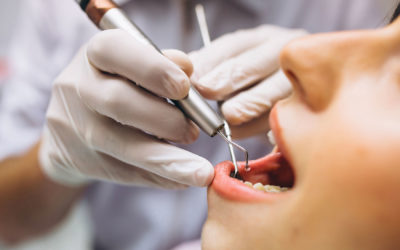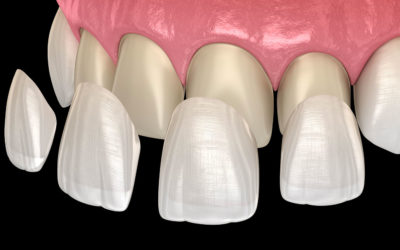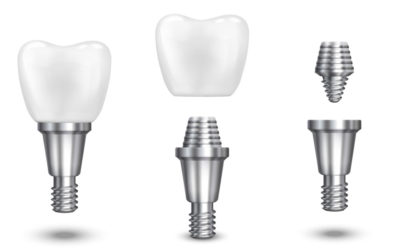
Dental implants in Geneva: 5 things to know
Tooth replacement is not just a cosmetic procedure. The loss of a tooth will above all lead to difficulties in chewing, and displacement of adjacent teeth, which will move and become elevated in the case of lower teeth, or lower in the case of upper teeth. This increases the risk of cavities and natural tooth decay, as well as damaging the jaw joints by complicating mandibular movements.
Following an accident, gum disease (periodontal disease), cavities or tooth loss, dental implants can restore chewing ability, oral comfort, smile aesthetics and self-esteem. As a result, patients are increasingly requesting these artificial roots. Before taking the plunge, it's a good idea to find out all you need to know on the subject.
What are dental implants?
Implantology is a medical specialty that aims to completely rebuild a missing tooth. A dental implant is an artificial root, often made of titanium, measuring between 4 and 18 mm in length and between 3 and 6 mm in diameter. The size of the implant depends on the type of tooth to be replaced (an incisor implant is smaller than a molar implant), and the bone volume of the jaw. The greater the bone volume, the longer and wider the implant, but in some cases, to avoid the need for bone augmentation, a smaller implant can be used.
This false root is placed inside the jawbone to replace one or more missing teeth. On top of this, the dental surgeon will place a fixed dental prosthesis (often a ceramic crown or bridge), or a removable one. These prostheses are made to measure, after conventional or digital impressions have been taken, according to the shape, position and color of the neighboring teeth and gums.
An implant has the cylindrical or conical shape of a natural tooth root. Inside the implant is an extremely precise connection for attaching a trans-gingival abutment, which supports a crown or bridge, as required.
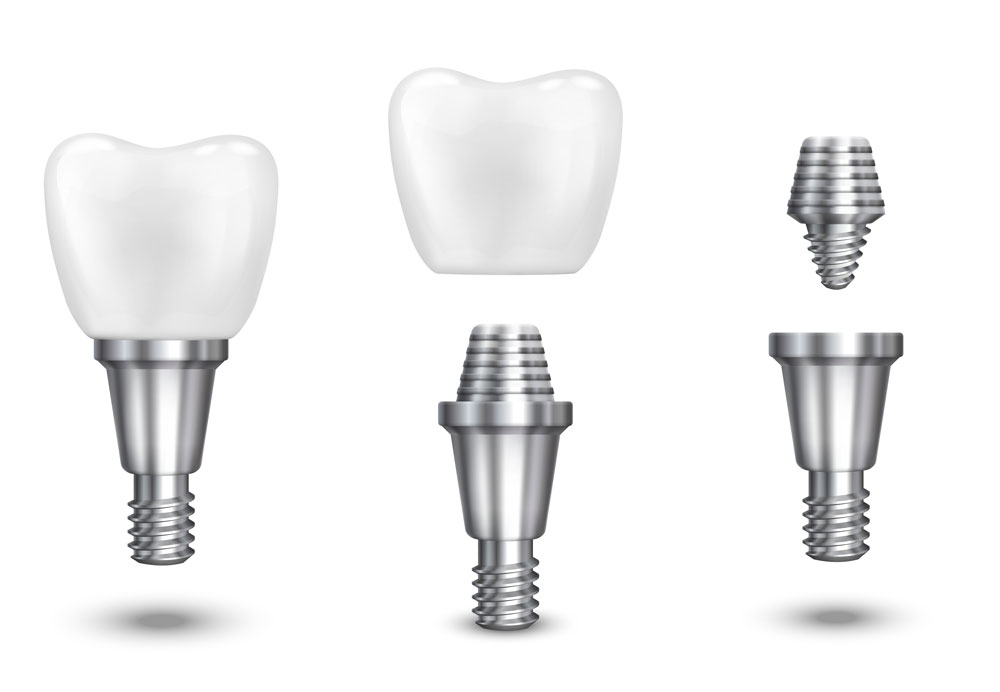
A dental implant consists of several superimposed layers:
Fixture, or the dental implant itself
This is an artificial root that is screwed into the bone. Its size is virtually identical to that of a natural root. Once the implant(s) are in place, the surgical site must be carefully closed to allow the implant to fully integrate with the jawbone. When the implant is placed, a cover screw (a small, flat screw) is inserted over the implant so that the gum can close completely over it. The advantage is that the closure screw remains deep under the gingiva and the gingiva covers it completely, allowing the wound to heal quietly and minimizing the risk of infection!
In the most favourable cases, where the risk of infection is low, a healing abutment can be directly inserted, which is a higher screw, usually 2 to 4 mm. This allows the gingiva to heal directly around the abutment. This will shorten the treatment time, reduce the number of interventions, and thereby reduce the cost of treatment.
The prosthetic implant abutment
In some cases, the future prosthesis cannot be screwed directly into the implant. It is therefore necessary to use an intermediate piece, called the implant abutment, which is screwed into the implant.
This element passes through the gum and serves as an anchor for the future prosthesis. These parts are rigorously designed to fit together perfectly and screw on without stress. They are generally made of titanium and are perfectly biocompatible.
Dental prosthesis: crown, bridge or removable prosthesis
The implant-supported crown:
The dental crown is the visible part of the tooth that protrudes from the gums. Attached to an implant, the artificial ceramic crown takes on a shape similar to that of natural teeth, restoring their aesthetics and function.
A dental crown is a unitary element. It is a fixed prosthesis used to replace a single tooth. It can be made from ceramic elements, composite resin or zirconia.
The Bridge: a dental bridge held together by abutments
A bridge is a prosthesis in the form of a "dental bridge". The bridge method, as the name suggests, involves fitting a bridge made up of several artificial teeth to fill the gap left by one or more lost teeth. The bridge is supported by two or more abutments, which frame the missing tooth or teeth. Dental bridges can also replace one or more teeth. Two implants can replace 3 teeth with a bridge, while a complete arch can be reconstructed with 6 to 10 implants.
Removable prosthesis
In the case of complete edentulism, if the jawbone does not permit the insertion of enough implants to create a fixed prosthesis (dental bridge), a limited number of implants can be inserted to stabilize a removable prosthesis (denture). This improves the chewing ability, comfort and self-esteem of denture wearers.
Dental implants are reliable and long-lasting
An implant has the ability to bond with the bone in which it is placed, through the phenomenon of osseointegration. A healing period is necessary to allow the implant to integrate properly with the jawbone (the bone that holds the teeth in place and which will accommodate the implant). During this time, the bone will reform around the implant and in the root grooves, so as to completely immobilize the device.
This natural phenomenon is established between 2 to 3 months and lasts theoretically all the life. It creates a very strong mechanical bond between the implant and the jawbone. Once fixed, the implant can withstand the forces of mastication that are exerted on it.
Dental implants guarantee bone stimulation to prevent bone resorption. It replaces a natural root that has already been extracted or compromised. That's why it's required in cases of tooth loss. Experience has shown that an implant is more reliable and resistant than a simple removable prosthesis or bridge.
While implants can last a very long time, there are a number of factors that play a part in the success of implant treatment, including: bone quality, balance of the prosthesis, distribution of forces on the implant and general health. But the two most important points are oral hygiene, and the frequency of visits to the hygienist after the operation: without appropriate preventive care, the gums around the implant can retract, and the implant can move and be lost.
The risk is greater for patients whose state of health reduces their immune defenses: diabetics and smokers, for example, are patients who need to be extra vigilant to ensure that their implants last a long time.
In general, 9 times out of 10, a dental implant lasts for many years. It is a reliable and robust technique with very few contraindications.
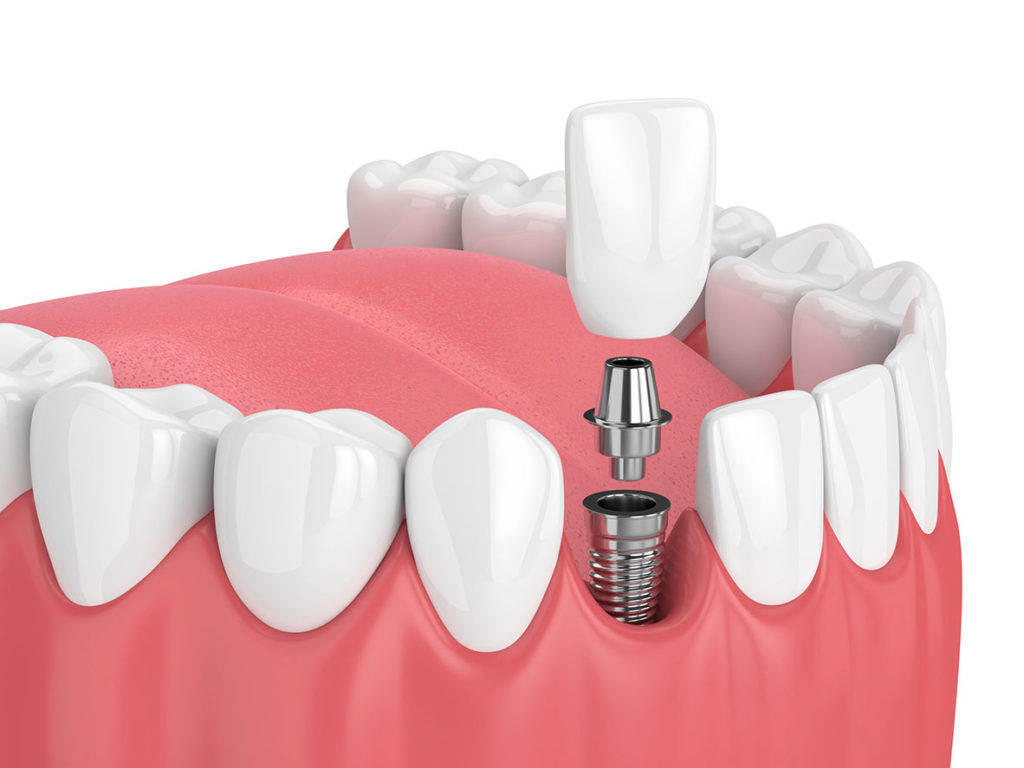
The different steps during surgery
The surgical procedure to place the implants takes place in the dental office, in a room specially prepared for the surgery. For safety reasons, it is performed under antibiotic cover. A simple local anaesthetic is all that's required, for perfect surgical comfort. In the case of more extensive surgery (involving multiple implants or major bone grafting), or for patients suffering from dental phobia, a general anaesthetic may also be considered.
The placement of a dental implant is a very common benign surgical technique. It takes place in 3 stages under rigorous aseptic conditions.
-
An incision is made in the gum to access the bone
Local anesthetics are used to make the surgery completely painless. The damaged tooth is removed. The gum is then gently peeled away to access the jawbone that will receive the dental implant.
-
Drilling to prepare the implant bed
During implant surgery, the dentist uses pre-calibrated pins, which enable the implant bed to be created progressively and gently, in proportion to the implant's dimensions. Drilling is carried out under saline irrigation to avoid overheating the bone, and to maintain optimal aseptic conditions.
-
The implant is then screwed into the jawbone
The implant insertion site is ready, and the implant is slowly inserted into its seat in the jawbone. A cover screw or healing abutment is then placed, which is a plug to protect the implant from food and prevent gingiva from getting inside.
Finally, sutures are applied to hold the gingiva in place.
Fitting a dental implant: several sessions are necessary
Implant treatment is a relatively lengthy process. We need to distinguish between two aspects of implant treatment: the placement of the dental implant on the one hand, and the connection to the implant-supported prosthesis on the other. The implant itself is a titanium screw that acts like an artificial root. This screw alone is ineffective for the patient, and only becomes useful when the prosthesis (crown or bridge, as the case may be) is connected. The implant-prosthesis assembly then fulfils its masticatory and aesthetic role.
As a result, several sessions are required to fully replace a tooth with an implant:
- A session to analyze the situation, and in complex cases, an in-depth analysis is necessary, which will require other complementary sessions (3D radiology, study impression, aesthetic analysis with smile design, recording of functional jaw movements with MODJAW...).
- A surgical session (screw placement) followed by a healing control session and suture removal.
- The prosthesis requires a minimum of two sessions: one to take a precision impression to determine the exact position of the implant in relation to the other teeth, and one to place the prosthesis in the mouth.
In addition, the bone and gum that will receive the implant is not always sufficient in quantity and/or quality, so it may be necessary to reconstruct the bone and/or gum before placing the implant, which consequently increases the number of sessions required.
Skipping steps and going too fast, filling a tooth in 1 session, carries a high risk of implant failure. By following rigorous, but longer, protocols, the odds are in our favor for success.
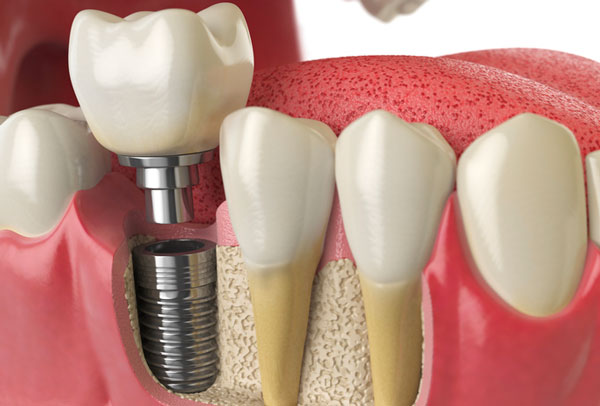
The quality of the implant guarantees a better result
If you choose a quality implant, the success rate will be over 98%. We strongly advise you not to worry about your health. If you have a quality implant fitted by a professional, the success rate of the operation will be high. It also guarantees better healing after surgery.
What determines the quality of the "top of the range" implants compared to the low cost ones is the precision of the prosthesis adjustment, the solidity of the connection screws, which guarantee a maximum life span of your implants.
On the other hand, certain factors can reduce the success rate of implants. If you smoke, you can expect a lower success rate (but still over 90%), as smoking delays implant healing. Diabetics also experience slower healing, and those with inflamed gums should have this problem treated before receiving an implant, as it can jeopardize the success of the operation.
Remember to maintain your dental implant
After a dental implant has been placed, it is important to know how to properly care for the device. The more care you take of the implant, the longer it will last. In general, patients who receive a dental implant are mainly "at risk" for caries, gum disease or periodontal disease. Hence the importance of good maintenance of the dental implant.
Do you need a dental implant fast? Are you looking for a specialized dental center?
The Centre Dentaire Champel is available to answer any questions you may have.

Do you need a dental implant quickly? Are you looking for a specialised dental centre? The Centre Dentaire Champel is available for any further information you may require.
Discover also the Centre Dentaire Lancy and the Centre Dentaire Chêne-Bourg



